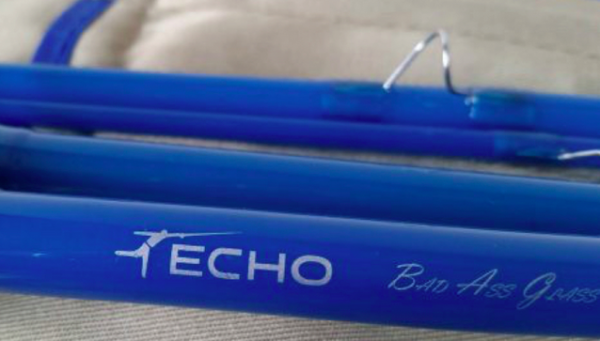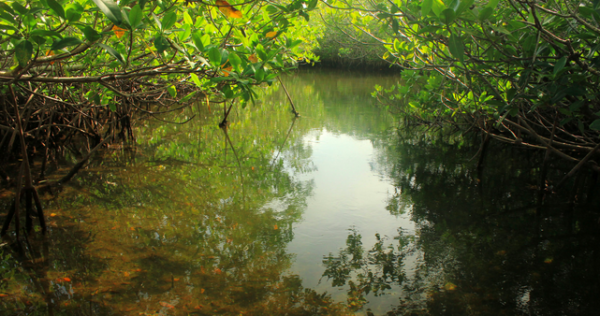By Skip Clement
Using short fly rods
[dropcap]F[/dropcap]ly rod makers, the most significant “trenders” in the fly fishing industry, have been focusing on making many kinds of fly rods that solve angling problems we didn’t know existed. It’s their job. Some think there’s a superabundance of makers, and some say too many ultra specialty fly rods are trying to address too many situations one could run into fly fishing in a myriad of venues.
In that mix, of course, there is trout fishing as well as briny water venues with confounding environments. In most restrictive trout settings and some saltwater settings, I believe my chances are better with shorter than 9-foot rods. These restrictions are commonly flora, rock walls, mangroves, boulders, rapids, incoming and outgoing tidal restrictions, transporting, overhangs – anything that makes fly delivery and line managing more problematic than normal. This is what drew me to the topic of short fly rods.

Echo Bad Ass Glass 8 foot fly rod.
Short rods are a whole new focus stirred by movers and shakers like Sage, T&T, Loomis, Winston, Scott, TFO, and the top survivors in the fiberglass rod making world. All of them point us to their newer collections of shorter rods and the myriad of uses they possess.

Tim Rajeff – Echo Fly Rods. One of the most innovative fly rod designers in the fly fishing industry.
He may talk faster than a New Jersey governor, but this West Coaster is sincere and knows what he’s talking about
Some are following Tim Rajeff at Echo’s lead. He’s been ahead of the short rod curve for years, as has to a lesser extent Orvis’ Superfine collection of both glass and carbon “smallie fly rods.”
Size does matter when fly fishing specific coordinates, and for me, that inaugural of thinking shorter sticks was born fishing Florida’s infamous Tamiami Trail, or the “Trail” as it’s regionally and colloquially known. On the Trail, a shorter stick can be a better choice, and sometimes a lot better. I find them more comfortable to fish in those confines and anywhere quick casting, short and spot-on are paramount.
A shorter stick isn’t always the best confined space fly rod choice
For example, if I were small stream nymphing in a confined space, and nymphing there was my entire day’s purpose, my best arrow would be in the newer trout-spey length fly rods or switch class length fly rods – even a Tenkara fly rod rigged to perform. A nine or less not as good, but certainly technically capable… to a point.
Each of those long fly rods covers much more real estate for the stationary angler better than a 9-foot or sub-nine fly rod. If you only thought of it concerning rod length and leader, the rest of the longer length assets come into focus.
A word about Tenkara – it’s an anglers’ career saver, fastest road to learning about how to fly fish, and an effective enough for a newbie to catch fish right now. While many dismiss it’s validity as a true fly rod, I believe it has no equal in that department.

Tight confines may draw you to a shorter fly rod.
Back to short sticks and an added value that some anglers are not aware of
I bought a Sage Bass rod a few years after it came out. The original Sage Bass fly rod, now called Bass II, is a short fly rod with a big heart. I bought it when the owner of the fly shop where I worked part-time (Fort Lauderdale Fly Shop) threw me a deal on a demo.
I wanted the 7’ 11” length rod to fish the Tamiami Trail, a walk-in fishery I came to know and love to fish. The short rod lined with 300 grain RIO line (spare reels afforded four different RIO lines) was perfect weaponry for up close and personal casting. The Trail is diverse fishery, but all venues call for serious control and seriously accurate casting, and quick and smooth deliveries. The Bass rod has excellent lift and turn capability, and is not temperamental while performing with a wide selection of fly lines – even lines best suited for touch and go water hauling.

The most popular how to fish South Florida on foot ever printed.
Fishing short rods on the Tamiami Trail with Steve Kantner
I had learned how to fish the western 30 or 40 miles of Tamiami Trail (State Route 41 – Miami to the Naples and beyond) from Steve Kantner back in the day when he was a guide – now an author and social media trender with an eye on things South Florida and beyond.
Steve mentored me on solving the mysteries of fly fishing in that western portion of the “Trail” for more than a decade. Primarily, the “Trail” is bordered by an elaborate canal system set up to drain and pollute the Everglades and water starve Everglades National Park – something the state of Florida is particularly good at.
All of what we fished was walk-in or backcountry from a canoe or self-propelling water conveyance. Almost all of where we fished was tidally influenced and required real-time knowledge of tides or be prepared to languish in the mud for at least six hours. High tide is mostly measured in passages of only inches.
Trail Rod
One unique need a fly fisher wants to own to fish the “Trail” successfully is a short fly rod for bridges and other tight ares. Certain “Trail” bridges are alive with snook. Naturally, a long rod of 9-feet will become a broken rod in less than a half-dozen outings, or less. Pitching a fly under a bridge could be hazardous to its health – water to road clearances of only a few feet while trying to catch feeding snook almost assure a broken tip-top.
Canals and tidally flowing waters in narrow confines protected by flora are also made for angling with shorter rods. A 25-pound tarpon or 30-inch snook is not going to park when hooked in an open cutout of water in the mangroves, among cypress roots, lily pads or other flora cover only a few feet away.

PRO4x ShortStix fly rod from G. Loomis received the award for Best New Fly Rod at the 2014 International Convention of Allied Sportfishing Tackle. Photo New England Boating.
What the pros have to say about short fly rods
The castability of a rod can be changed with the relationship between it and the taper of the fly line. A fly line with a short head loads a short rod efficiently and allows the angler to deliver big flies short to moderate distances quickly. The opposite works for longer rods, slow. Rods exceeding the 9-foot mark benefit from fly lines with longer heads.” — Steve Rajeff.
The length differentials of 1-foot and even 6-inches might not seem like much, but they make a difference in both casting and delivery.” — John Frazier
Ian Scott Devlin was one of the rod designers for G Loomis Short Stix along with Mark Sedotti and Steve Rajeff.
Short (7’6”-8’ or so) stiffer tapered rods are very useful for most fly fishers casting short belly style flylines and a wide range of sized flies from a boat. These rods force you to deliver the cast quickly too, and you can even use just your wrist to cast them. Aside from obvious leverage advantages when fighting fish with a shorter lever, you simply come through the casting stroke with more torque with less effort.”— Ian Scott Devlin – co-designer of Loomis Short Stix
8 foot, 10 weight Epic Bandit FastGlass fly rod
A quick adjustment in your casting stroke is all that is needed to get in tune with these style rods
Sage Bass II, G. Loomis ShortStix, TFO Mini Mag, etc. What Mark Sedotti and I brought to the table was distance casting these genre rods. They are long known to be the tool of choice close in casting into heavy cover with larger fly patterns. By far much more easier to cast accurately too. The two big disadvantages with rods like these are picking up and recasting to a seen fish beyond 60-feet. A 9’ or 10’ rod is clearly a better lever here. Sight fishing quick shots less than 60-feet away, the shorter rods have huge advantages regarding nimbleness and accuracy.
Another disadvantage is mending and roll casting, but we rarely do much of that in saltwater. Best selling weight for 80% of fishing in the Northeast would be a G. Loomis ShortStix 9/10 Wt or 10/11Wtcasting a 425 grain short belly style flyline. Airflo Sniper, Wulff Ambush or Saltwater Triangle Taper, Rio Outbound Short, or similar style 25-foot – 30-foot head lines. Only one or two backcasts and shoot the fly to the fish… pronto.” — Ian Scott Devlin
Sage Dart.

Tune in
Once tuned in to shorter than 9-foot rods you will come to know when to use it. In many cases with a short fly rod, it’s choosing one because you know success is in quick and compact delivery, accuracy, and the ability to effectively put the screws to a strong fish. If you add in other benefits not so easily bestowed on short fly rods, you will have to give credit to less physical taxation on your wrist, arm and shoulder – body part combos that are almost 90% of the act of casting.
Among the top quality albie fisherman that I guide on my boat in the Fall, there are more than a few that absolutely swear by the shorter rods to fight fish effectively and make fast shots to moving targets. Those two things are of paramount importance to effectively catch albies. — Capt. Andrew Derr
A short fly rod with a short fly line head loads better, casts quicker, fights fish better and delivers a variety of fly sizes. Steve Rajeff agrees.
Anglers can effectively fish in tight using heavier lines with short heads and do so accurately and quickly, even with bulky flies short to mid-range distances. I always see some guys using a short rod when stripers and bluefish are feeding on large menhaden.” — Steve Rajeff
Some short rod adversaries try to punch holes in using them by claiming they suffer from long cast deficiencies. The question then is, just exactly what is too short? My Sage Bass rod, rigged currently with an OPST 275 grain short shooting head fly line and 85-feet of Lazur running line suffers no pain reaching 80-feet with one pick up of the head and a few feet of the running line.
Short rods have big Fighting Power
Another not so surprising attribute of most short fly rods is stoutness which means controlling the catch. Keeping a 30-pound tarpon from running to cover in mangroves is a success in the first seconds or a complete and frustrating loss if unleashed for 30 seconds or more. A hookup and immediate control are not measured in minutes. If you haven’t turned the tarpon right now, you’re going to lose it.
Wanna buy a short rod? Try them all.
So what if you have decided to take advantage of what short rods have to offer? What now? Not all short fly rods are created equal. You need to hit the fly shop, or borrow your buddy’s and test drive it. I never buy a fly rod that hasn’t been in the parking lot outside the fly shop and hurled a few dozen times at car bumpers… looking for a feel I like at different ranges – most short or under 40-feet. Overhead, sidearm, bow and arrow, backhand, and so on. When you do purchase, find out from the manufacturer or other owners what lines they recommend to pair with your new hot rod. Lining these rods correctly is essential to their success and will improve their castability and your enjoyment. So go out and “Get Shorty!”










Join the discussion 2 Comments